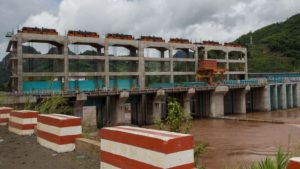
Rethink plans to dam Mekong after Laos disaster
Barrage collapse highlights risks and need for alternative energy sources
10 August 2018
The collapse of the Xe-Pian Xe-Namnoy dam after heavy rains last month that killed more than 30 in Laos and left thousands of Lao and Cambodian people homeless is reigniting an urgent debate about preventing similar tragedies in future.
In a welcome move, the Laos government this week announced a review of safety standards at dams currently under construction and a suspension of approvals for new projects.
While a lot of attention will now doubtless focus on how to build better dams, the review is an opportunity to consider alternative energy sources. The best risk mitigation strategy is to avoid barrages as much as possible — and focusing on other energy sources such as solar, wind and biomass. These are all economically feasible alternatives for the most risky proposed hydropower projects.
The collapse highlights the cross-border risks to damming the Mekong river, which runs through China, Myanmar, Laos, Thailand, Cambodia and Vietnam.
The region’s planned construction of more than 100 dams is already delivering a death of a thousand cuts to the Mekong’s rich ecosystems. The flows of fish and sediment are key providers of food security. Cambodia’s Tonle Sap is the world’s most productive freshwater fishing ground, and its fish rely on the Mekong remaining a relatively free-flowing river to migrate and breed. The Mekong river also delivers nutrient-rich sediment to the delta, contributing to Vietnam’s high agricultural productivity and naturally mitigating the impacts of rising sea-levels.
Hydropower dams threaten these natural cycles as well as the livelihoods and food security of the 70 million people who depend on the river’s bounty. While dam proponents claim that mitigation efforts — such as fish ladders and sediment-flushing gates — can alleviate some of the impact, doubt is cast on these claims by numerous peer-reviewed studies, including the recent Mekong River Commission Council Study.
The Xe-Pian Xe-Namnoy dam is one of more than 140 dams planned on the Mekong and its tributaries in Laos and Cambodia. About one third are already completed, and another third are currently under construction. Hydropower dam construction is a priority for Laos’s national economic development plan, which envisages Laos gaining much-needed revenue by exporting hydropower and developing up to a projected 28,000 megawatts of capacity. Altogether, if the planned schemes are completed in full, the Lower Mekong basin could have a generating capacity of more than 40,000 MW, of which more than 5,000 MW is already in place another 5,000 MW is under construction.
Upstream from Laos, China now operates eight megadams with the capacity of 19,000MW on its portion of the Mekong, called the Lancang in China. These dams are blamed for many of the current impacts downstream and indeed have reduced the Mekong’s sediment load by 40%.
In Laos and Cambodia, China has built more than 20 dams which are now mostly rolled into the Belt and Road Initiative which is pumping in financing.
The dam collapse is just one of many recent shocks to Laos’s plans to become the “Battery of Southeast Asia.” One challenge is hydropower’s competitiveness: global studies show large dams are often far more expensive than anticipated. These costs are passed on in electricity costs and undermine the business case for hydropower, raising questions about its long-term competitiveness and about Laos’s export plan.
Such calculations already affect decision-making. In March 2018, the Electricity Generating Authority of Thailand (EGAT) temporarily suspended the power purchase agreement for the Pak Beng dam in Laos. The 912 MW project was one of the largest planned dams for the Mekong mainstream in Laos, and 90% of the electricity generated was tagged for sale to Thailand.
The Pak Beng suspension is linked to Thailand’s revision of its national power development plan (PDP), which should be complete in September. It is expected to confirm whether Thailand will incorporate significantly more solar and wind, the prices of which continue to fall, into its national energy mix.
Thailand’s Ministry of Energy is giving mixed signals over the revision, but most analysts expect Thailand will cut imports from Laos and Myanmar in favor of more domestically produced renewable energy. Thailand’s solar capacity has more than doubled since 2014 to more than 3,300 MW in 2017, putting Thailand more than halfway towards its national target of 6,000 MW by 2036. Thailand’s Ministry of Energy recently raised the 2036 non-hydro renewable energy target from 20% to 30%.
Significant institutional resistance to such a large increase in renewable energy generation could hamper a more forward-looking plan. The Thai electricity authority is worried that the proliferation of private solar, wind and biogas projects will threaten its traditional business model which favors government-owned assets, including large hydropower projects in Laos such as the collapsed Xepian-Xe Namnoy dam, where it holds a minority stake.
Thailand already faces a glut of generating capacity. Official figures show the national power reserve has already exceeded 30% of peak demand since 2016, due to lower-than-projected consumption rates. This is far higher than the international standard of a 15% reserve margin. Even without the replacing imported hydropower with domestically produced solar, many proposed Laos dam projects are already unnecessary in the light of Thailand’s high reserve margin.
If the PDP revision leads to the cancellation of the Pak Beng dam, Laos’s plans to become the “Battery of Southeast Asia” will require a deep rethink. Thailand has a memorandum of understanding (MOU) in place to purchase 9,000 MW by 2020, and it is the only country currently buying such a significant amount of power from Laos. Depending on the outcome of the PDP revision, it is possible that Thailand could walk away from this agreement entirely.
Thailand would be wise to invest in a forward looking power system that avoids pulling power from far-flung generation assets across its borders and taps into robust renewable endowments at home.
Without Thailand as a major off-taker, the remaining six dams planned on the Mekong mainstream in Laos, adding to the two already under construction — and many of the 100-plus planned on the tributaries — would become commercially unviable. Laos’s power export market is left without clear alternatives. China has a massive electrical energy capacity surplus, and the only other country that could import such a large amount of Lao power in the near-to-medium term is Vietnam. Vietnam has an MOU to buy 5,000 MW from Laos, but its government is naturally hesitant to increase hydropower imports since studies consistently show that Mekong dams will devastate the delta.
Vietnam could negotiate an increase of power imports whereby Hanoi agrees to purchase power only from dams sited in places that cause the least disruption downstream. Vietnam and other development partners can help the Lao power sector switch to solar and wind to replace foregone dams.
There is also room for China to move away from its traditional outbound investment in coal and dams and invest — under BRI — in non-hydropower renewables to demonstrate its commitment to becoming an “ecological civilization.”
For Hanoi to negotiate from a strong position, it must rule out Vietnamese companies from investing in high-risk dams, such as the proposed Luang Prabang dam on the Mekong mainstream. Doing so would help meet Vietnam’s growing energy demand and reduce its dependence on coal, whilst ultimately minimizing risks to the delta and helping Laos meet its development goals.
The Laos government would do well to take a broad approach in the review it has has launched following the Xe-Pian Xe-Namnoy disaster. Even if alternative energy sources are not part of the remit they must be part of the wider political discussion. With cooperation with Vietnam and other neighbors, Laos, the poorest country in the region, become a greener, cleaner and far less risky “Battery of Southeast Asia.”
Source: https://asia.nikkei.com/Opinion/Rethink-plans-to-dam-Mekong-after-Laos-disaster



